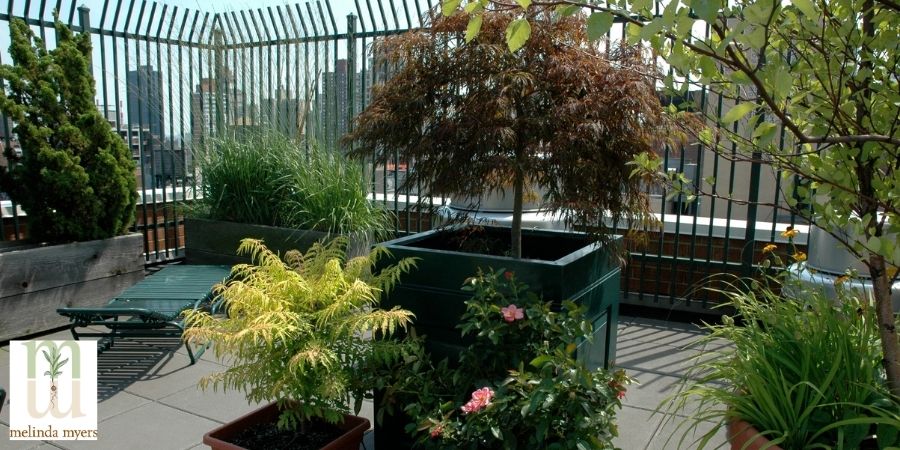Growing Trees and Shrubs in Containers
- horticulturist and gardening expertNovember 14, 2020
Growing trees and shrubs in containers expands your plantable space, adds seasonal and vertical interest to the landscape, provides screening and helps you transform a patio, balcony or deck into a beautiful garden oasis. As a longtime small space gardener in the city I have grown my share of trees, shrubs and perennials in containers. These included a Japanese maple, weeping lilac, chamaecyparis and Garden Glow dogwood along with an assortment of perennial vines and flowers. And even though I now garden on a larger property I continue to grow trees and shrubs in planters. Some are not hardy and need to be moved indoors for winter and other help dress up my patio.
And containers are not just for ornamental trees and shrubs. More and more gardeners are growing edible plants including fruit trees and shrubs. Small-scale container-friendly varieties are making it easier for everyone, both small and large space gardeners, to grow these plants in pots on balconies, patios and decks. Bushel and Berry® has introduced lots of compact berry plants and Urban Apple® and other columnar apples are perfect for growing in containers.
Let me walk you through the process of planning, selection and care of growing trees and shrubs in containers.
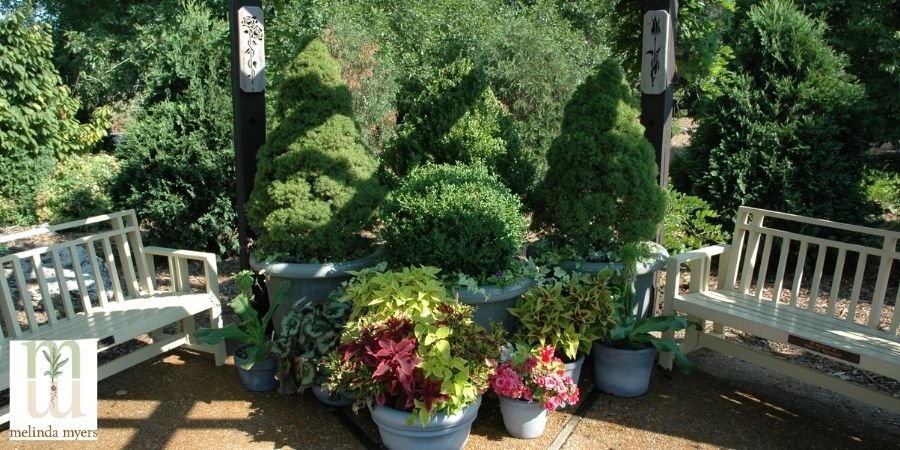
Coleus, Begonia and Evergreens in Containers
Evaluate the Growing Conditions for Container Trees and Shrubs
As always it is important to match the plant you select to the growing conditions. This includes sunlight, moisture and seasonal temperature extremes. But when growing in containers you also need to consider root hardiness. The above ground parts of plants are hardier than the roots. This is usually not an issue since soil is a great insulator. But container trees and shrubs are growing in a small volume of soil exposed to temperatures extremes so the roots are not as well insulated.
As a northern gardener I am always concerned about plants surviving our brutal winters. Although trees are rated for the cold hardiness these ratings do not reflect the root hardiness or the colder temperatures these roots are exposed to in the container. The same can be said for the extreme heat in hotter regions. Temperatures in the container mix are significantly greater than those in-ground potentially killing roots and impacting overall plant health.
You can find lists of trees and shrubs recommended for containers. I have included some below. Your best bet is to observe those thriving in containers in your area. In general select plants at least one zone hardier than your cold hardiness zone. And for those in milder climates look for those plants that are also more heat tolerant.
Selecting the Container for a Tree or Shrub
When selecting a container for your plantings aesthetics is one concern. You want the style and material to complement your landscape design and home’s architecture. But you also need to select one made from a material that will tolerate your weather extremes. I love glazed and terracotta pots but these are subject to cracking when water freezes it expands and cracks these pots. I have had luck with plastic pots lasting several years as long as I did not hit them with the shovel when removing snow. By the time they faded or started deteriorating, it was time to transplant the tree or shrub into a larger container. But many gardeners do not find these suitable for their landscape design.
Fiberglass containers come in a variety of colors, sizes and shapes and tolerate most weather extremes. Metal is another option. But the insulation from temperature extremes is minimal so usually not a great option for those gardening in areas with extremely cold or hot temperatures. Fiber pots come in a variety of sizes and colors. Frequently used for annual flowers, vegetables and herbs, I have used them with a few perennials plants, including small berry plants. These pots are lightweight and many have handles for easy moving.
I also grow trees and shrubs in nursery pots. You may have some in your shed left from previous landscape projects or you may find them in a recycling bin at the garden center. I plant my trees and shrubs in these pots then set them inside a decorative pot for the summer. In fall I lift the potted plant out of the decorative container and move it into winter storage. The decorative container is safely tucked away for winter.
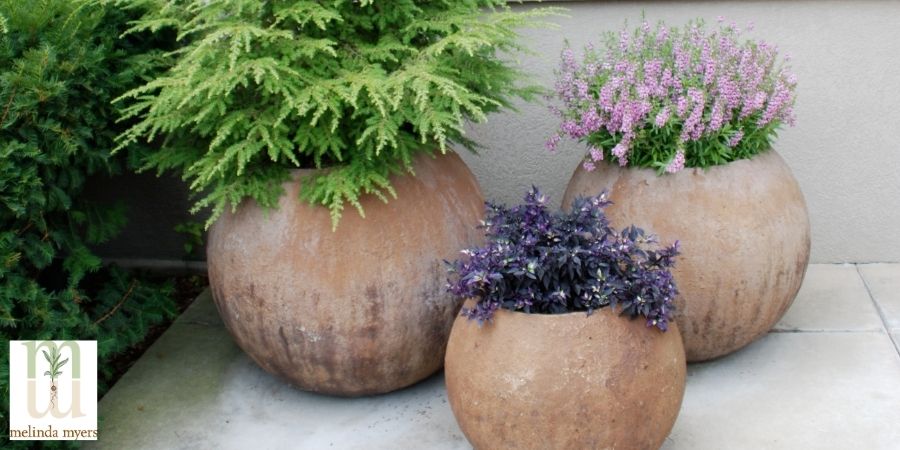
Hemlock, Lavender and Purple Flash Pepper Ball
Size of the container is also important. The bigger the container the greater the root insulation and better your chances of success. But large containers can be quite heavy especially those made from wood, pottery or cement. Add to this the weight of moist soil and a mature plant. This is a concern when growing trees and shrubs in containers on balconies and decks or if you opt to move the containers out of the way for entertaining or into storage for winter. Make sure the structure can support this added weight and you are able move them as needed.
Make sure the container you select has drainage holes. Even if you can water perfectly nature may “overwater” your plants. Consistently waterlogged soil leads to root rot and death.
Self-watering containers have reservoirs for water and wicks or other means for water to move from the reservoir into the soil. You will still need to fill the reservoir but less often than watering a planter without this feature. These planters should have weep holes to allow excess water to drain out of the reservoir when it reaches capacity. A plugged drainage hole at the bottom allows you to drain excess water out of the reservoir for winter in cold regions.
Some professionals and gardeners add a layer of insulation to the inside of the container. A 1 or 2” layer of flexible wool, foam or similar insulation will work.
Growing a tree or shrub in its own container provides maximum space for the plant and increases growing success. You can cluster several containers together in an area to create a display of several trees and shrubs.
Selecting the Growing Mix for Tree and Shrub Containers
Just like any garden or container the planting mix is critical to growing success. Look for a quality planting mix that has adequate drainage and water holding capacity.
Placing your garden soil in a container is not the solution. These soils do not provide adequate drainage or water holding ability when placed in a container.
Consider using planting mixes with a variety of organic and inorganic materials such as pine bark, compost, sand and expanded clay. Peat moss can be hard to rewet if it dries out and perlite and vermiculite are lightweight floating to the planting mix surface. You are likely limited to the planting mixes available at your local garden center. Start with those you have had success with in the past and adapt as needed.
Selecting Trees and Shrubs for Containers
As mentioned above look for trees and shrubs suited to the growing conditions. This includes wind, sunlight, summer heat and winter cold. Select trees and shrubs that are at least one zone hardier than your location and are heat tolerant. Consider drought tolerant plants that are more forgiving if regular watering is a challenge. Irrigation systems and self-watering pots can help expand your options by reducing your time spent watering.
Look for trees and shrubs that provide seasonal interest. Flowers, fruit that do not create a mess, fall color, interesting bark and attractive form. Many of these also attract butterflies and songbirds adding color and motion to the landscape. Evergreens provide year-round greenery and shelter for songbirds.
Select trees and shrubs with a growth habit suitable for the landscape design that will fit in the available space. Cascading plants make great focal points, upright varieties are used for screening and vertical accent while wider branched plants soften structures but take up more space.
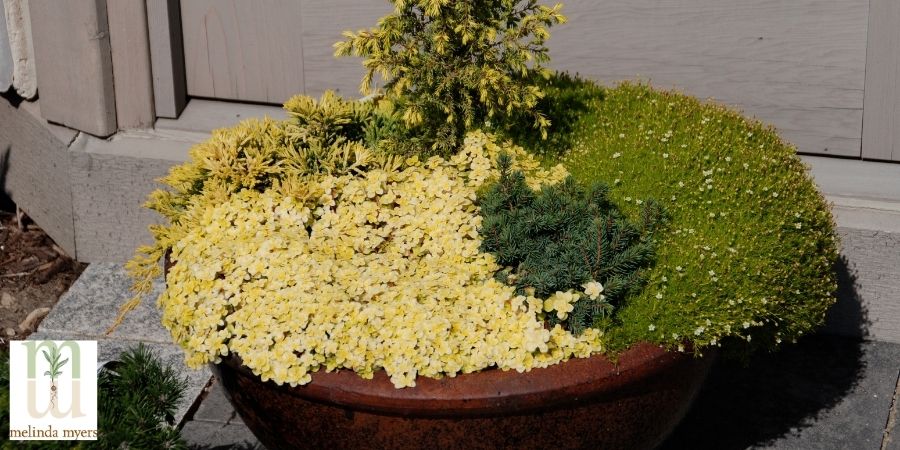
Dwarf Conifer
Dwarf, semi-dwarf and small-scale trees and shrubs are great options for containers. And breeders have been working to introduce more small-scale plants for the landscape and containers.
Here are a few plants to consider. Make sure they are hardy in your area, complement your landscape design and match your maintenance practices.
Trees
Check mature size and consider smaller or dwarf varieties.
Apples (Malus) – may need two for pollination and fruit formation
Citrus (Citrus spp)
Crabapples (Malus spp.)
Crape Myrtle (Lagerstroemia indica)
Dogwoods
Kousa dogwood (Cornus kousa)
Corneliancherry (Cornus mas)
Ginkgo (Ginkgo biloba)
Maples
Japanese maple (Acer palmatum)
Paper bark maple (Acer griseum)
Trident maple (Acer buergerianum)
Magnolia
Star (Magnolia stellata)
Little Girl Series of Saucer Magnolia (Magnolia x soulangeana)
Pines (Pinus spp.)
Pomegranite (Punica granatum)
Redbuds (Cercis spp)
Serviceberries (Amelanchier spp)
Smoketree (Cotinus coggygria)
Spruce (Picea spp.)
Sweet Bay (Laurus nobilis)
Weeping Blue Atlas Cedar (Cedrus atlantica ‘Glauca’)
Shrubs
Check mature size and consider smaller or dwarf varieties as needed.
Arborvitae (Thuja occidentalis)
Azalea (Rhododendron spp)
Boxwood (Buxus)
Chinese Fringe-flower (Loropetalum chinense)
Dogwood (Cornus spp)
False cypress (Chaemacyparis spp)
Holly (Ilex spp.)
Junipers (Juniperus spp.)
Lilacs (Syringa spp)
Ninebark (Physocarpus opulifolius)
Panicle hydrangeas (Hydrangea paniculata)
Rhododendron (Rhododendron spp)
Rose (Rosa spp)
Rosemary (Rosmarinus officinalis)
Weigela (Weigela spp)
Winterberry (Ilex verticillata)
Witchhazel (Hamamelis spp)
Yews (Taxus)
Rooftop Container Tree and Shrub Container
Year-round Maintenance of Trees and Shrubs
Proper watering is even more critical when growing trees and shrubs in containers. The soilless planting mixes dry out more quickly than garden soil. The small volume of planting mix in the container is exposed to hotter and drier conditions and will dry out more quickly than your garden. Water thoroughly when the top few inches of soil are dry. Check daily but only water when needed.
Mulch the soil with shredded bark, woodchips or other organic material. This is often overlooked for planters but is just as important as mulching garden beds. Mulch helps insulate the roots, conserve moisture and suppress weeds. Spread a 2 to 3 inch layer of mulch over the soil surface pulling it back from tree trunks and shrubs stems.
Soilless mixes not only dry out more quickly than garden soil they also do not retain nutrients as long. Apply Milorganite to your container planters each spring. This low nitrogen slow release fertilizer provides a several months of nutrients. It also contains 85% organic matter help improve the planting mix. Make a second application mid summer if needed. Those in colder regions should stop fertilizing by August 1st to help plants prepare for winter.
Rotate planters displayed against walls and fences. This ensures all sides of the plants receive sufficient sunlight encouraging even growth.
Prune broken and damaged branches as soon as they are discovered. Follow the same guidelines for container trees and shrubs as those specimens growing in a garden. You may need to prune container trees and shrubs regularly to maintain the desired size.
Winter protection varies depending on where you live. Those in milder climates where temperatures do not drop below freezing can continue normal care. Watering frequency will decrease as temperatures cool or if plant growth slows or the plant goes dormant over winter.
Those in climates where winter temperatures drop below freezing need to prepare their plants for the cold weather ahead.
- Drain the reservoir in self watering pots if needed before freezing temperatures arrive.
- Move planters with less hardy trees and shrubs to more moderate locations.
- A sheltered outdoor location. Insulate the roots if needed by surrounding the container with bales of straw, mulch, bags of leaves or similar materials.
- An unheated garage. Insulate roots as needed and water anytime the soil is thawed and dry.
And if you are successful your trees and shrubs will eventually outgrow the container.
- Move it to the next size container. Be sure to loosen any roots that encircle the root ball. And make sure you can handle the larger size container.
- Trim roots by an inch or two and replant in the same container. This can be risky but may be your only option.
- Move the plants into the landscape and plant a new smaller specimen in the container.
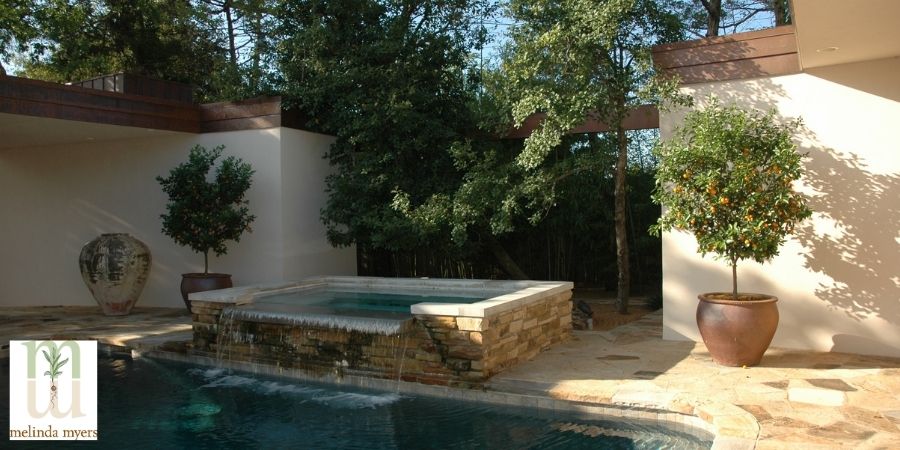
Fruit Trees in Containers
A Few Tricks
- Place planters on wheeled caddies to make moving and rotating large pots easier.
- Make sure the wheels can be locked in place.
- Planters with built in wheels allow you to easily move the planter out of the way for parties and other gatherings.
- Potlifter is a handy device for moving containers. The strap is placed around the pot and connected to two handles. This makes it easy for two people to work together and to move uniquely shaped pots.
- Plant your trees or shrub in one of the nursery pots. Then set this pot inside the decorative pot. In fall the trees or shrub can be lifted out and moved into winter storage. This is especially useful if you bury the pot in a vacant part of the garden for winter.
Keep records of your successes and failures just as you do with all your gardening projects. The more experience you gain the greater your results. And most importantly have fun as you add new trees and shrubs to your landscape.

